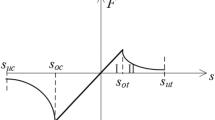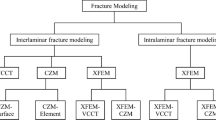Abstract
A boundary element method based numerical model is presented to simulate the nonlinear fracture process zone in cementitious materials. A cohesive type stress-separation constitutive relationship (σ-w curve) is incorporated in the model to represent the process zone. Numerical algorithms for both force-controlled (prescribed loading history) and crack-tip-control-led (prescribed crack tip position) are implemented to allow whole range simulations, including strain-softening and snap-back behavior. The numerical program includes special features to permit re-adjustment of nodal points such that accurate determination of the crack-tip position is achieved. A series of numerical simulations on both 3-point beams and double cantilever beams (DCB) are conducted to investigate the development of the inelastic process zone with respect to load level, loading configuration, specimen size, and the stress-separation relationship in the process zone. Size effect on fracture resistance is clearly demonstrated. Conclusions are drawn regarding the importance of determining the details of σ-w curve (i.e., the values of f t and w c )and the need for re-evaluating the R-curves approach in cementitious materials.
Similar content being viewed by others
References
Bazant, Z. P. (1976): Instability, ductility and size effect in strain-softening concrete. J. Eng. Mech. Div. 102, E2, 331–344
Bazant, Z. P. (1984): Size effect in brittle failure of concrete structures. J. Eng. Mech. 110, 518–535
Bazant, Z. P. (1985): Fracture in concrete and reinforced concrete. In: Bazant, Z. (ed.): Mechanics of geomaterials, pp. 259–303. New York: Wiley
Bazant, Z. P. (1985): Determination of fracture energy from size effect and brittleness number. ACI Material J. Nov.-Dec., 463–480
Bazant, Z. P., Oh, B. H. (1983): Crack band theory for fracture of concrete. Mater. Struct. (RILEM, Paris), 16, 155–177
Carpinteri, A. (1982): Application of fracture mechanics to concrete structure. J. Struct. Div. 108, ST4, 833–848
Carpinteri, A. (1989): Size effect on strength, toughness and ductility. J. Eng. Mech. 115, 1375–1392
Colombo, G., Limido, E. (1983): Un metodo numerico per l'analisi di prove TPBT stabili, confronto con alcuni dati sperimentali, XI Convegno Nazional dell'Associazione Italiana per L'Analisi delle Sollecitazioni, Torino, pp. 233–243
DiTommaso, A (1984): Evaluation of concrete fracture. In: Carpinteri, A.: Ingraffea, R. (eds): Fracture mechanics of concrete, pp. 31–65. The Hague: Martinus Nijhoff
Foote, R. M. L.; Cotterell, B.; Mai, Y. W. (1980): Crack growth resistance curve for a cement composite. Advances in cement-matrix composites, Symposium L, Materials Research Society, Boston, MA, pp. 135–144
Gerstle, W. H.; Ingraffea, A. R.; Gergely, P. (1982): The fracture mechanics of bond in reinforced concrete. Report 82-7, Department of Civil Engineering, Cornell University
Hillerborg, A. (1985): Numerical method to simulate softening and fracture of concrete. In: Sih, G. C.; DiTommaso, A. (eds): Fracture mechanics of Concrete, pp. 141–170. Martinus Nijhoff Publishers, Dordrecht:
Hillerborg, A.; Modéer, M.; Peterson P. E. (1976): Analysis of crack formation and crack growth in concrete by means of fracture mechanics and finite elements. Cem. Concr. Res. 6, 113–182
Jenq, Y. S.; Shah, S. P. (1985a): A fracture toughness criterion for concrete. Eng. Fract. Mech. 21, 1055–1069
Jenq, Y. S.; Shah, S. P. (1985b): A two parameter fracture model for concrete. J. Eng. Mech. Div. 111, 1227–1241
Lenian, J. C.; Bunsell, A. R. (1979): The resistance to crack growth of asbestos cement. J. Mater. Sci. 14, 321–332
Liang, R. Y.; Li, Y. N. (1991): A study on size effect by fictitious crack model. J. Eng. Mech. (in press)
Li, V. C.; Liang, E. (1985): Fracture process in concrete and fiber reinforced cementitious composites. J. Eng. Mech. 112, 566–586
Li, V. C.; Ward, R. J. (1988): A novel testing technique for post-peak tensile behavior of cementitious materials. Proc. Int. Workshop of Fracture Toughness and Fracture Energy—Test Methods for Concrete and Rock
Mindess, S. (1984): Fracture toughness testing of cement and concrete. In: Carpinteri, A.; Ingraffea, R. (eds): Fracture mechanics of concrete, pp. 67–110. The Hague: Martinus Nijhoff
Mindess, S.; Lawrance, F. V.; Kesler, C. E. (1977): The J-integral as a fracture criterion for fiber reinforced concrete. Cem. Concr. Res. 7, 731–742
Peterson, P. E. (1981): Crack growth and development of fracture zones in plain concrete and similar materials. Report TVBM-1006, Div. of Building Materials, Lund Institute of Technology
Rice, J. R. (1968): A path independent integral and the approximate analysis of strain concentration by notches and cracks. J. Appl. Mech. 35, 379–386
Roelfstra, P.; Wittmann, F. (1987): Numerical modeling of fracture of concrete. Transact. 9th Int. Conf. Struc. Mech. Reactor Technol. pp. 41–50
Shah, S. P. (1984): Dependence of concrete fracture toughness on specimen geometry and on composition. In: Carpinteria, A.; Ingraffea, A. R. (eds.): Fracture mechanics of concrete pp. 111–135. The Hague: Martinus Nijhoff
Shah, S. P.; Chandra, J. (1968): Critical stress, volume change, and microcracking of concrete. J. ASCE. 65, 770–781
Shah, S. P.; Slate, F. O. (1968): Internal microcracking, mortar-aggregate bond and the stress-strain curve of concrete. Cem. Concr. Assoc., 82–92
Shah, S. P.; Winter, G. (1968): Inelastic behavior and fracture of concrete. SP-20, ACI, 5–28
Shah, S. P.; McGarry, R. J. (1971): Griffith fracture criteria and concrete. J. Eng. Mech. Div. 47, EM6, 1633–1676
Visalvanich, K.; Naaman, A. E. (1982): Fracture modeling of fiber reinforced cementitious composites. Report 82-1. Department of Materials Engineering, University of Illinois at Chicago Circle
Wecharatana, M.; Shah, S. P. (1980): Double torsion tests for studying slow crack growth of portland cement mortar. Cem. Concr. Res. 10, 833–844
Wecharatana, M.; Shah, S. P. (1982): Slow crack growth in cement composites. J. Struct. Div. 108, ST6, 1400–1413
Wecharatana, M.; Shah, S. P. (1983a): Predictions of nonlinear fracture process zone in concrete. J. Eng. Mech. 109, 1231–1245
Wecharatana, M.; Shah, S. P. (1983b): Nonlinear fracture mechanics parameters. In: Wittman, F. H. (ed.): Fracture mechanics of concrete, pp. 463–480. Amsterdam: Elsevier
Author information
Authors and Affiliations
Additional information
Communicated by S. N. Atluri, January 23, 1990
Rights and permissions
About this article
Cite this article
Liang, R.Y.K., Li, Y.N. Simulations of nonlinear fracture process zone in cementitious material—a boundary element approach. Computational Mechanics 7, 413–427 (1991). https://doi.org/10.1007/BF00350169
Issue Date:
DOI: https://doi.org/10.1007/BF00350169




